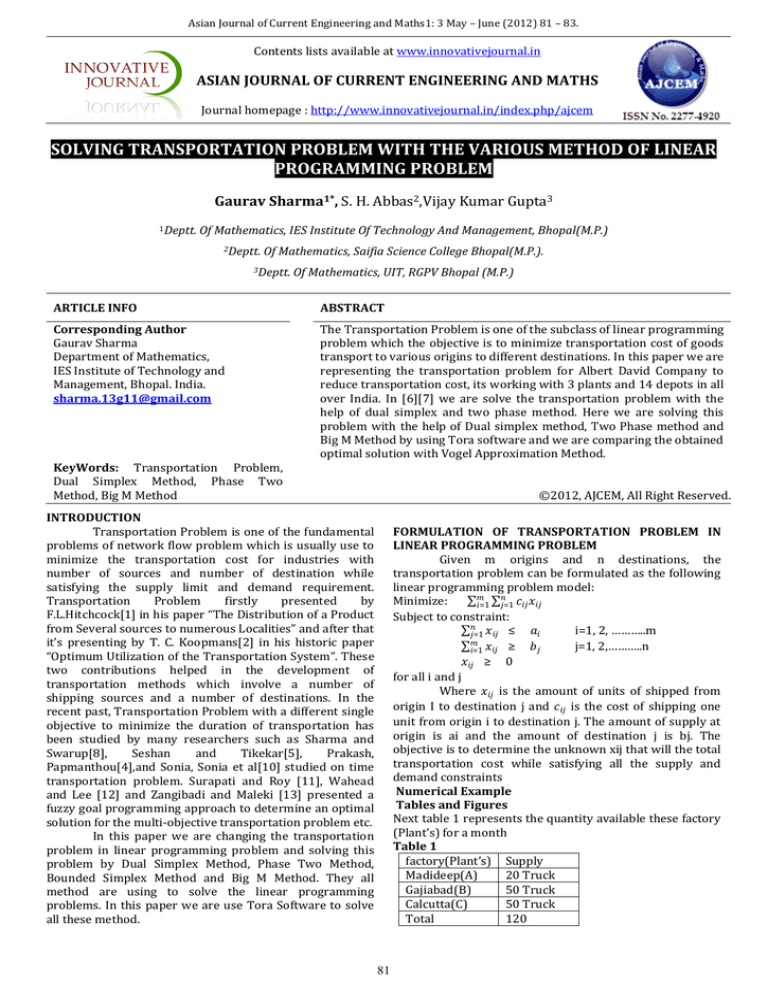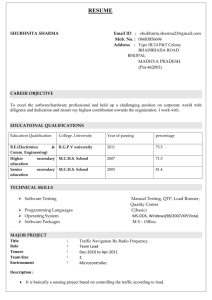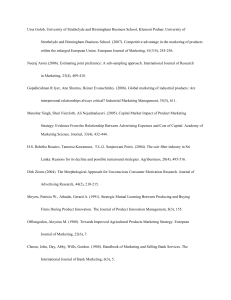
Asian Journal of Current Engineering and Maths1: 3 May – June (2012) 81 – 83.
Contents lists available at www.innovativejournal.in
ASIAN JOURNAL OF CURRENT ENGINEERING AND MATHS
Journal homepage : http://www.innovativejournal.in/index.php/ajcem
SOLVING TRANSPORTATION PROBLEM WITH THE VARIOUS METHOD OF LINEAR
PROGRAMMING PROBLEM
Gaurav Sharma1*, S. H. Abbas2,Vijay Kumar Gupta3
1Deptt.
Of Mathematics, IES Institute Of Technology And Management, Bhopal(M.P.)
2Deptt.
Of Mathematics, Saifia Science College Bhopal(M.P.).
3Deptt.
Of Mathematics, UIT, RGPV Bhopal (M.P.)
ARTICLE INFO
ABSTRACT
Corresponding Author
Gaurav Sharma
Department of Mathematics,
IES Institute of Technology and
Management, Bhopal. India.
sharma.13g11@gmail.com
The Transportation Problem is one of the subclass of linear programming
problem which the objective is to minimize transportation cost of goods
transport to various origins to different destinations. In this paper we are
representing the transportation problem for Albert David Company to
reduce transportation cost, its working with 3 plants and 14 depots in all
over India. In [6][7] we are solve the transportation problem with the
help of dual simplex and two phase method. Here we are solving this
problem with the help of Dual simplex method, Two Phase method and
Big M Method by using Tora software and we are comparing the obtained
optimal solution with Vogel Approximation Method.
KeyWords: Transportation Problem,
Dual Simplex Method, Phase Two
Method, Big M Method
©2012, AJCEM, All Right Reserved.
INTRODUCTION
Transportation Problem is one of the fundamental
problems of network flow problem which is usually use to
minimize the transportation cost for industries with
number of sources and number of destination while
satisfying the supply limit and demand requirement.
Transportation
Problem
firstly
presented
by
F.L.Hitchcock[1] in his paper “The Distribution of a Product
from Several sources to numerous Localities” and after that
it’s presenting by T. C. Koopmans[2] in his historic paper
“Optimum Utilization of the Transportation System”. These
two contributions helped in the development of
transportation methods which involve a number of
shipping sources and a number of destinations. In the
recent past, Transportation Problem with a different single
objective to minimize the duration of transportation has
been studied by many researchers such as Sharma and
Swarup[8],
Seshan
and
Tikekar[5],
Prakash,
Papmanthou[4],and Sonia, Sonia et al[10] studied on time
transportation problem. Surapati and Roy [11], Wahead
and Lee [12] and Zangibadi and Maleki [13] presented a
fuzzy goal programming approach to determine an optimal
solution for the multi-objective transportation problem etc.
In this paper we are changing the transportation
problem in linear programming problem and solving this
problem by Dual Simplex Method, Phase Two Method,
Bounded Simplex Method and Big M Method. They all
method are using to solve the linear programming
problems. In this paper we are use Tora Software to solve
all these method.
FORMULATION OF TRANSPORTATION PROBLEM IN
LINEAR PROGRAMMING PROBLEM
Given m origins and n destinations, the
transportation problem can be formulated as the following
linear programming problem model:
𝑚
𝑛
Minimize:
𝑖=1 𝑗=1 𝑐𝑖𝑗 𝑥𝑖𝑗
Subject to constraint:
𝑛
𝑎𝑖
i=1, 2, ………..m
𝑗=1 𝑥𝑖𝑗 ≤
𝑚
𝑥
≥
𝑏
j=1,
2,………..n
𝑗
𝑖=1 𝑖𝑗
𝑥𝑖𝑗 ≥ 0
for all i and j
Where 𝑥𝑖𝑗 is the amount of units of shipped from
origin I to destination j and 𝑐𝑖𝑗 is the cost of shipping one
unit from origin i to destination j. The amount of supply at
origin is ai and the amount of destination j is bj. The
objective is to determine the unknown xij that will the total
transportation cost while satisfying all the supply and
demand constraints
Numerical Example
Tables and Figures
Next table 1 represents the quantity available these factory
(Plant’s) for a month
Table 1
factory(Plant’s) Supply
Madideep(A)
20 Truck
Gajiabad(B)
50 Truck
Calcutta(C)
50 Truck
Total
120
81
Sharma et. al/ Solving Transportation Problem with the various method of Linear Programming Problem
Next table 2 represents the total demand of the warehouses
in various places. These supplies for a month
Table 2
Warehouses Demand
Bhopal(X)
10
Raipur(Y)
06
Mumbai(Z)
14
Total
30
Table 4
(X) (Y) (Z) Capacity
(A)
8
10 20
0
20
(B)
40 30 55
0
50
(C)
20 25 35
0
50
Demand 10 6
14
90
Linear Programming Problem Formulation of
Transportation Problems
Now we are converting the transportation problem in
Linear programming problem by using table 4
Minimize:
Z=
8X11+10X12+20X13+40X21+30X22+55X23+20X31+25X
32+35X33
Subject to constraint:
X11 + X12 + X13 ≤ 20 …………………(I)
X21 + X22+ X23 ≤ 50 …………………(II)
X31 + X32 + X33 ≤ 50…………………(III)
X11 + X21 + X31 ≥ 10…………………(IV)
X12 + X22 + X32 ≥ 6…………………..(V)
X13 + X23+ X33 ≥14 …………………(VI)
X11, X12, X13, X21, X22, X23, X31, X32, X33 ≥ 0
After Using Tora Software on Transportation Problem and
Linear Programming Formulation of Transportation
Problem we are getting the optimal solution of our
transportation problem which solving for Albert David
Company to reduce transportation cost presented in
following table:
FORMULATION AND TABLES
In this problem we make a transportation problem
for Albert David Company as being the essential
commodity. We get the following transportation model to
determine an optimal solution so as to minimize the
transportation cost.
Table 3
(X) (Y) (Z) Capacity
(A)
8
10 20 20
(B)
40 30 55 50
(C)
20 25 35 50
Demand 10 6
14
Here Σ ai = 120, Σ bj = 30. since Σ ai ≠ Σ bj, we introduce
the dummy warehouse “D” with the demand 90 trucks and
zero transportation cost, as shown in the next table in the
form of balanced transportation problem:Table 5
Name of Methods
Occupied cell / Constraints
Optimal Solution
Vogel Approximation Method
X11 = 0,
X24 = 50,
X12 = 06,
X31 = 10,
X13 = 14
X34 = 40
Rs 5,40,000
Big-M Method
X31 = 10,
S4 = 50,
X12 = 06,
X 33 = 00 ,
X13 = 14
S5 = 40
Rs 5,40,000
Two-Phase Method
X31 = 10,
S4 = 50,
X12 = 06,
X 33 = 00 ,
X13 = 14
S5 = 40
Rs 5,40,000
Dual Simplex Method
X31 = 10,
S1 = 50,
X12 = 06,
X 11 = 00
X13 = 14
S2 = 40
Rs 5,40,000
CONCLUSION
We have established the uniqueness and existence
of optimal solution of the transportation problem for Albert
David Company. This has been brought out through
developed
transportation
problem
into
linear
programming problem and applying the discuss methods in
paper which yields the same four optimal solution as
shown in table 5 and have stated the optimality conditions
of the problem. And we get all method give the same result
but dual simplex method is best with respect to VAM
because dual simplex have minimum no. of iterations.
REFERENCES
1. Hitchcock, F. L. “The distribution of product from
several source to numerous localities”, J. Maths. Phy. ,vol
20, (1941), pp 224-230
2. Koopman, T.C. “Optimum utilization of transportation
system”, Proc. Intern. Statics. Conf. Washington D.C.,
(1947)
3. Prakash, S. "On minimizing the duration of
transportation", Proceedings of the Indian Academy of
Sciences-Mathematical Sciences, Vol. 91, ( 1982), pp5357
4. Papamanthou, C., Paparrizos, K., Samaras N.
"Computational experience with exterior point
algorithms for the transportation problem", Applied
Mathematics and Computation, Vol. 158, ( 2004),
pp459-475
5. Seshan, C. R., Tikekar, V. G. “ On the Sharma Swaup
algorithm for time minimizing transportation
problems”, Proceeding of Indian Academy of Sciences
Mathematical Science, Vol. 89, (1980), pp 101-102
6. Sharma, Gaurav; Abbas, S. H.; Gupta, Vijay“Optimum
Solution of Transportation Problem with the help of
phase-II method of Simplex Method”, Indian journal of
applied life science, Vol. 6, No. 1 & 2, (2011), pp 49-54
7. Sharma, Gaurav; Abbas, S. H.; Gupta, Vijay “Dual Simplex
Algorithm for Proctor & Gamble to Solve Transportation
Problem”, Journal of Ultra Scientist of Physical Sciences,
vol. 23, No. 2, (2011)
8. Sharma, J.K., Swarup, K. "Time minimizing
transportation problem", Proceedings of Indian
Academy of Sciences-Mathematical Sciences, Vol. 86, (
1977), pp513-518
9. Sonia, Khandelwal, A., Puri, M.C. "Bilevel time
minimizing
transportation
problem",
Discrete
Optimization,Vol. 5, No.4, ( 2008), pp714-723
10. Sonia, Puri, M.C. "Two level hierarchical time
minimizing transportation problem", Top, Vol. 12, No.2,
( 2004), pp301-330,
82
Sharma et. al/ Solving Transportation Problem with the various method of Linear Programming Problem
11. Surapati, P. and Roy, T. K. “Multi-objective
transportation model with fuzzy paparmeters: Priority
based fuzzy goal programming approach”, Journal of
Transportation Systems Engineering and Information
Teachnology, Vol. 8, (2008) pp 40-48
12. Wahead, W. F. and Lee, S. M. “Interactive fuzzy goal
programming
problem
for
multi-objective
transportation problem”, Omega, Vol. 34, (2006) pp
158-166
13. Zangibadi, M and Maleki, H. R. “Fuzzy goal programming
for multi-objective transportation problem”, Applied
Mathematics and Computation, Vol. 24, (2007), pp 449460.
83





